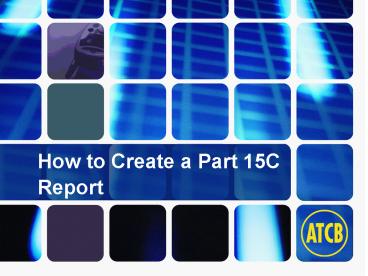How to Create a Part 15C Report - PowerPoint PPT Presentation
1 / 23
Title:
How to Create a Part 15C Report
Description:
Part 15C is the Rule section set aside for 'Intentional Radiators' ... An Intentional Radiator is the legal term used by FCC to cover all cases of low ... – PowerPoint PPT presentation
Number of Views:46
Avg rating:3.0/5.0
Title: How to Create a Part 15C Report
1
How to Create a Part 15C Report
2
What is Part 15C?
- Part 15C is the Rule section set aside for
Intentional Radiators - Covers low power devices which are License
Exempt - Part 15D, E, and F devices also are considered
Intentional Radiators and follow the outline of
this chapter. Only Part 15C devices are
considered here because they generally are more
common
3
What is an Intentional Radiator
- An Intentional Radiator is the legal term used by
FCC to cover all cases of low power license
exempt transmitters. These transmitters typically
are used for short range communications, remote
control, or field disturbance sensors. - Each rule has it is own requirements.
4
Test Report Construction Notes
- All Part 15C devices use ANSI C63.4 as a basis
for report construction. - All Part 15C reports use all information in the
previous Part 15B presentation, and then adds
more requirements. - See How to Create a Part 15B Report
5
Building a Test Report
- All Part 15 filings use ANSI C63.4 as a guide for
building Test Reports. - See Section 10 for general report requirements.
- Details of the measuring equipment and OATS are
required. - Photographs of the Test Setup are necessary.
6
Required Exhibits
- AmericanTCB has its own easy-to-use application
form in MS Word format for use in all filings. A
completed Application is required before any work
can proceed. - In addition to the Test Report a number of
specific Exhibits are required.
7
Exhibits which accompany all filings
- Label
- Internal Photographs
- External Photographs
- Cover Letters
- Operational Description
- Schematics
- Block Diagrams
- Manual
- Test Setup Photographs
- Can be held Confidential
8
Additional Exhibits
- Part 15C Spread Spectrum transmitters (802.11g
and Bluetooth) are required to submit RF Exposure
information because the Rules allow relatively
high power. - Part 15D (Unlicensed PCS) and Part 15E (802.11a)
also have specific RF Exposure requirements
9
RF Exposure
- RF Exposure is a complex area and is relatively
one of the newest sections of the Rules.
Requirements are still changing and may need
additional care before testing or filing - Check and consult with ATCB to determine if any
recent regulatory changes
10
Finding FCC Regulations
- The Government Printing Office now provides
on-line FCC Rules. - These are the most recent available and usually
are the best for updates - http//ecfr.gpoaccess.gov/cgi/t/text/text-idx?cec
frtpl2Findex.tpl
11
(No Transcript)
12
(No Transcript)
13
(No Transcript)
14
(No Transcript)
15
Laboratory Test Procedures
- The FCC does not maintain a current listing of
test procedures for Part 15C devices. - FCC prefers to use industry standards from IEEE.
However, many changes are not documented
adequately. - Check with ATCB for proper current testing
methodologies.
16
Restricted Bands
- Certain protected frequency bands are considered
vital to our national interests. No transmitter
may have any fundamental emissions within the
specified bands in the following table - Only radiated spurious emissions which meet the
Class B limits are permitted
17
(No Transcript)
18
Antennas
- FCC considers Part 15 transmitters to be approved
as a unified system from the transmitter, coax
and antenna. - Only antennas approved with the device are
allowed to be used. - New or additional antennas are permitted but only
through the Class II Permissive Change process
19
Antenna Connectors
- Antenna connectors accessible by the end user
must be unique. - The idea is that they should discourage the end
user from ever utilizing any non-approved
antennas - Must fail the Radio Shack test
20
Amplifiers
- Amplifiers are not permitted to be added to any
Part 15 transmitter except in very explicit
situations. - Amplifiers must be paired with specific,
separately approved and Certified unlicensed
intentional radiators only. - Very specific and restrictive marketing
requirements apply.
21
Controls
- End users must not be given any ability to change
the operating parameters to operate outside of
its operational parameters. - For 802.11g devices, this means that the end user
must not be given access to country codes to
allow operations on Channels 12 or 13.
22
Modular Approvals
- Modular Approvals and Limited Modular Approvals
(LMA) are permitted under the Rules. - These allow third party manufacturers to
incorporate Certified transmitters into their
equipment easily - Specific additional documentation requirements
are required. - See ATCB for the latest changes to Modular
Approval interpretations
23
Questions?
- whgraff_at_atcb.com
- major_at_atcb.com
- jerry_at_atcb.com
























![Market Report on China Valve Industry [2010-2019] PowerPoint PPT Presentation](https://s3.amazonaws.com/images.powershow.com/8328572.th0.jpg?_=20151214064)






